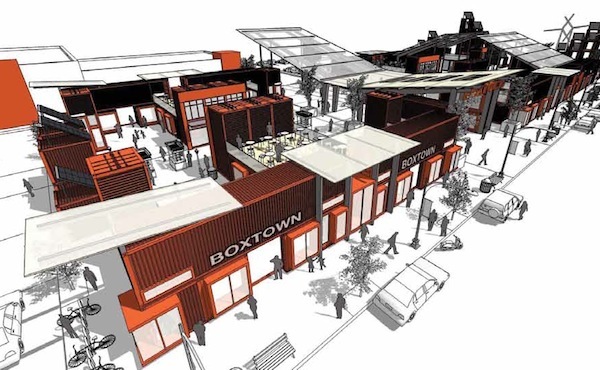Boxman Studios, the recognized leader in modified shipping containers, has launched a new division aimed at sustainable solutions for the Built Environment. The Boxman Studios Buildings Division will focus on the adaptive use of decommissioned shipping containers as architectural elements and even complete buildings.
The company hired veteran sales director Jim Curtis to manage its foray into the Built Environment sector. "Here at Boxman Studios we are fascinated with what we can do with shipping containers. In the right hands, these big metal boxes are extremely pliable," says Curtis. "With our success in the Events and Trade Show industries since 2008, we're perfectly positioned to move into the built environment with a narrative of unique design, modularity, flexibility, and value."
The launch of the new division comes on the heels of Boxman's recent move into a 65,000 square foot facility in North Charlotte. "Our new building means that all facets of an operation are under one roof. We can easily scale as needed," says Boxman Studios' CEO David Campbell. "Launching into container architecture for the Built Environment was a logical next step for our company."
"The Buildings Division will focus on the permanent and semi-permanent use of our creations. We envision modifying containers as structural and design elements in office buildings, retail stores, apartments, multi-family residential, public markets, pop-up restaurants, transit stations, even for emergency response purposes," Curtis added. "We're excited about the next phase in our company's growth."
About Boxman Studios
Founded in 2008, Boxman Studios offers design, development, and deployment services of customized shipping containers, modifying them for a range of markets and applications around the world.
Related Stories
Architects | May 20, 2016
NCARB survey indicates continued growth of U.S. architects
The number of U.S. architects surpassed 110,000 in 2015, a 2% increase from the previous year.
Multifamily Housing | May 19, 2016
Architect Jean Nouvel designs flood-resilient Monad Terrace in Miami Beach
A man-made lagoon with lush vegetation at the base of the complex is expected to adapt to climate change and rising sea levels.
Building Team Awards | May 19, 2016
Chinatown library unites and serves two emerging Chicago neighborhoods
The 16,000-sf, pebble-shaped Chinatown Branch Library was built at the intersection of new and old Chinatown neighborhoods. The goal is for the building to unite the communities and serve as a catalyst for the developing area.
Building Team Awards | May 19, 2016
NYC subway station lights the way for 300,000 riders a day
Fulton Center, which handles 85% of the riders coming to Lower Manhattan, is like no other station in the city’s vast underground transit web—and that’s a good thing.
Market Data | May 17, 2016
Modest growth for AIA’s Architecture Billings Index in April
The American Institute of Architects reported the April ABI score was 50.6, down from the mark of 51.9 in the previous month. This score still reflects an increase in design services.
Architects | May 16, 2016
AIA and HOK partner to advance Design and Health Research Consortium
The groups' key priority is to identify and develop practice-focused opportunities for funded research, publications, and tools in the area of design and public health.
Senior Living Design | May 16, 2016
Perkins Eastman releases white paper on biophilic design in senior living
The paper highlights some of the firm's top projects that feature biophilic design, a sustainable architecture strategy that connects people with nature.
Architects | May 16, 2016
3 strategies to creating environments that promote workplace engagement
VOA's Pablo Quintana writes that the industry is looking for ways to increase engagement through a mix of spaces suited to employees' desire for both privacy and connection.
Architects | May 11, 2016
AIA to create a resilience curriculum for architects
The program will teach resilient design and decision-making on hazard mitigation, climate adaptation and community resilience.
Retail Centers | May 10, 2016
5 factors guiding restaurant design
Restaurants are more than just places to eat. They are comprising town centers and playing into the future of brick-and-mortar retail.

















